Bee Lab: Designing for Wild Bee Conservation & Biodiversity
- Sustainable Development

In the Fall of 2021, this Designmatters Studio challenged students to discover the rich diversity and current challenges facing local wild bee species. Working with biologists, scientific researchers and community advocates, student teams conducted field research, interviewed experts and conceptualized conservation outreach efforts that would benefit bees and help humans better understand these insects as important ecological links.
Students explored how biomimicry can serve as a resource in their design solutions; additionally, they were advised to approach the subject as systematic network that mimics nature itself through complex, interrelated and nested-dependent design ecosystems. Teams created innovative campaign solutions that incorporated products, services, spatial interventions and events.
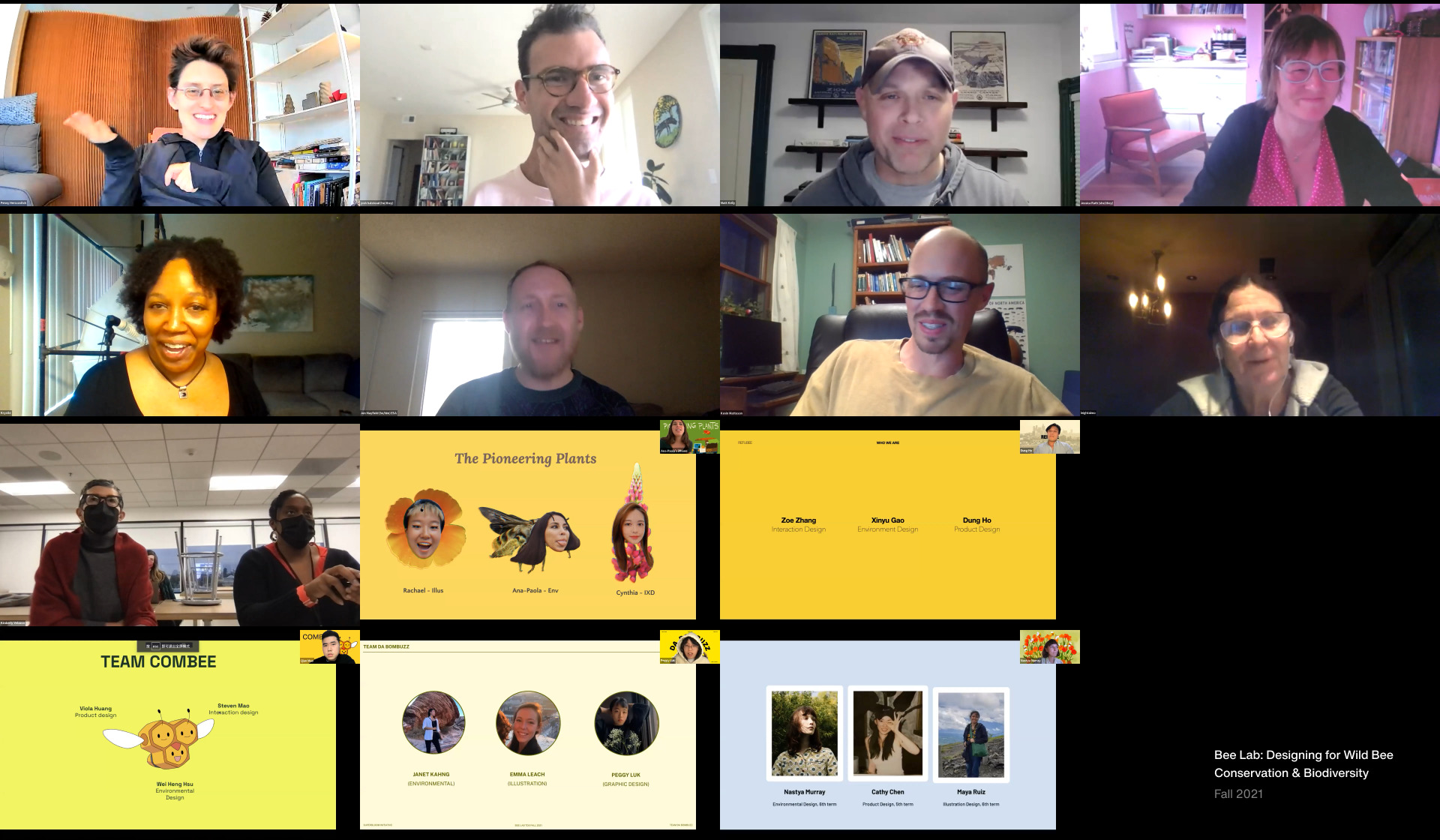
Why did I sign up for this studio? I thought it would be delightful to design for bees rather than humans for a change.
Janet Kahng, ArtCenter student (Environmental)
Project Brief
This Designmatters Studio introduced students to the diverse species of local wild bees and the vital role they play in a healthy ecosystem – especially in the Los Angeles urban environment – along with the current issues that are threatening their existence. Students delved into academic research, interviewed policy experts, biologists and community activists, and conducted field research as the foundation for their ideation.
Employing biomimicry and a systematic approach to their final project challenge, students created interrelated ethical conservation outreach efforts that incorporated products, services, spacial interventions and events – all directed to highlight the importance of native wild bees and how human efforts can assist and help these winged wonders thrive.
About Wild Bees
According to the Xeres Society, there are an estimated 20,000 species of bees worldwide with approximately 3,600 species native to North American north of Mexico. California is home to about 1,600 native bee species.
Unlike honey bees – which are not native to North America – wild bee species range in length from about 1/12 inch to more than 1 inch long. They vary in color (dark brown or black to red or metallic green and blue); some have stripes of white, orange, yellow or black.
Bees play an essential role in maintaining a healthy ecosystem and support diversity. They are the most important group of pollinators, creatures that deliberately gather pollen to bring back to their nests for their offspring. On a single foraging trip, a female bee may visit hundreds of flowers, transferring pollen the entire journey.
More than 90 percent of the North American bee species lead solitary rather than social lives. Solitary bees typically live for about a year – spending their early months hidden in a nest and growing through egg, larval and pupal stages.
Climate change is just one of the many challenges facing native bees today along with habitat loss, commercial farming and pesticides.

With the topic of bees, these were a lot of benefits of being a virtual studio. We were able to engage amazing subject matter experts who are all over the country and from so many fields: journalists, documentarian biologists, architects, scientists – that’s an incredible number of resources for our students. Our high-flex field trips were also great example of how we can offer enriching experience for those students in-person and those remote.
Penny Herscovitch, instructor
Research and Project Development
At the kickoff, students introduced themselves and shared initial concepts they gleamed from their own outdoor wild bee field observations. After recapping of the studio by the instructors, a panel of experts discussed important elements about wild bees.
Kevin Mattson, from the biology department of the University of Miami, studies bees in urban areas, gave an overview of the challenges bees face living in cities and how they have adapted and are using the built environment. He shared architectural examples of how design can complement bees, citing bee boxes and other pollinator environments.
Mattson acknowledged the benefits of community gardens in dense cities, and introduced the students to the diversity of wild bees while sharing bee facts: not all bees live in hives, many do not sting, and not all are pollinators. Mattson stressed that when proper native plants are introduced into a bee-less area, bees eventually will find the flowers.
Matt Kelly, creator of The Bee Report newsletter and podcast, shared his experiences in the field with wild bees and also provided students with online resources and case studies to consider in their research-collecting phase.
He explained that while the honey bee is a well-known bee, that species has been introduced to North America and should not be considered in the student’s design thinking. Kelly advocated that students immerse themselves in evidence-based science and understand the local bee communities around them.
After the presentations, students questioned the panelists during a lively virtual conversation. Students left the class with plenty of information for reflection. Teams convened and began their research phase, from online sources to in-person observations to visiting built environments.
Students engaged in a hands-on workshop about systems mapping, a frame-working method that can influence and streamline their design. This approach examines specific challenges and available resources that uncovers areas of opportunities and presents directions that are passionate, impactful and feasible. These leverage points – and intersections between points – allow students to fill in the gaps with creative thinking that directly addresses the challenge at hand. Overall, systems mapping thinking pointed the students to connect their concepts to a larger picture.
As students continued their research gathering, they discovered reasons for the decline in native bee populations as well as the important link between native plants and bees. Additionally, research uncovered many disparities in certain neighborhoods which brought many student teams to involve social justice aspects into their design thinking.
Development Presentations
In front of a virtual audience, student teams shared their initial observations and research results along with possible areas of opportunities for their final projects. Joining the instructors were subject matter experts that also included Krystal Hickman, a native bee photographer at Arlington Gardens in Pasadena.
Teams described their research learnings and questions they hope to answer. They outlined their systems map, leverage points, targeted audience (commuters, school age children, etc.) and possible design directions. Students shared rough sketches, and described outdoor locations they visited and interviews they conducted that sparked their conceptual thinking. Teams also discussed the next steps they currently envision, possible prototypes they would like to create and additional research that would support their ideas.
Comments from the stakeholders provided valuable insights for the students; experts posed specific questions, offered suggestions on possible partnerships and reminded students to consider the overall ethics of what their ideation implies. Students were energized by their enthusiasm which helped move them forward with more specific goals and targets.
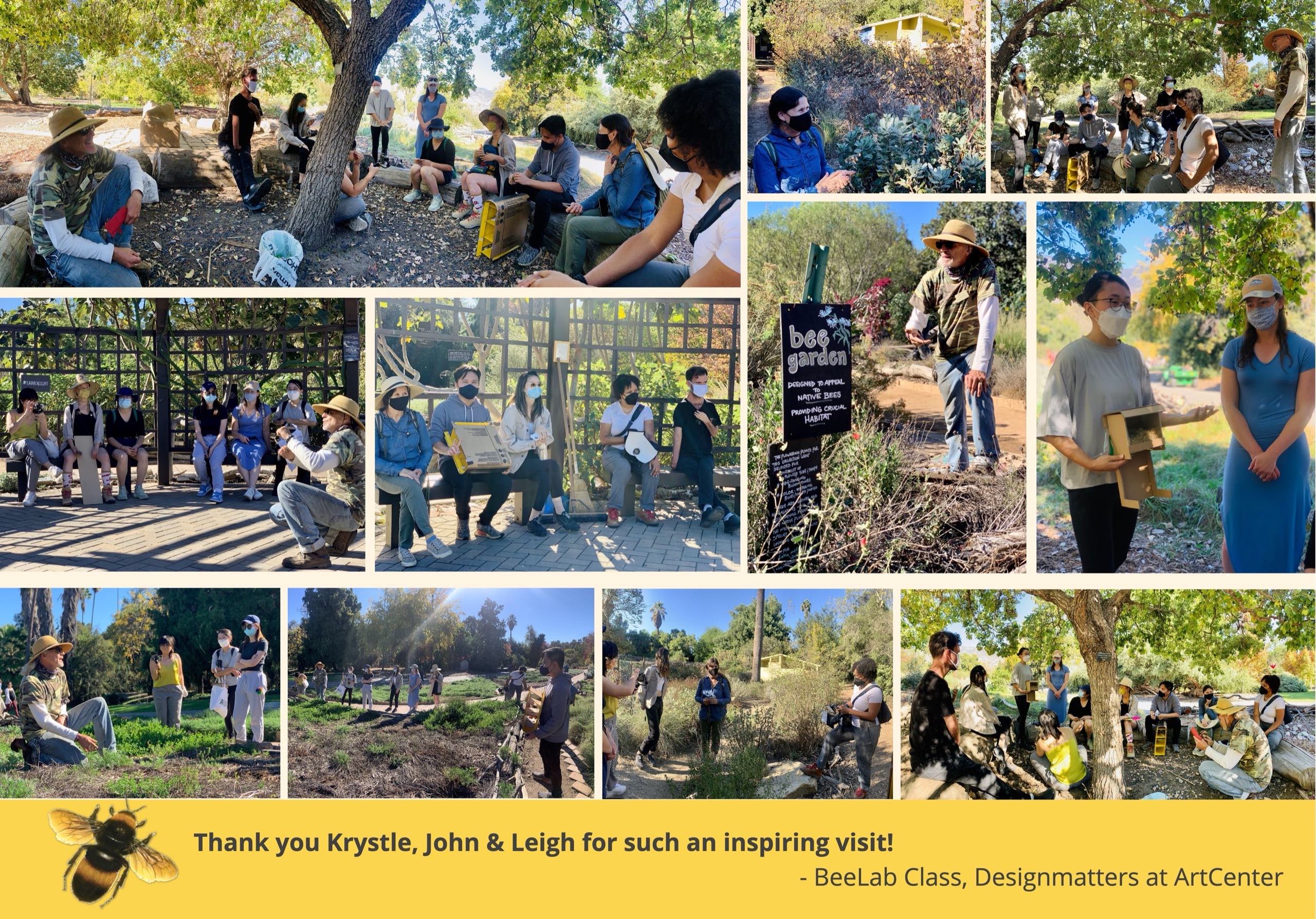
One A-ha moment for me was during the field trip to the L.A. Arboretum in Arcadia. I asked a gardener about the bee hotel and he showed an abandoned bee hotel that was hung on a post. I realized that we don’t have to make things permanent, but memories of experiences can be. The challenge is design a tool that people with different skillsets and ages can easily create together. Design should be effortless and it should blend well with nature.
Dung Ho, ArtCenter student (Product Design)
As a class, student attended field trips (remotely and in-person) to Pasadena’s Arlington Gardens and Crescent Farms in Arcadia which deepened their enthusiasm for the project.
A presentation from Joel Garcia – Designmatters Indigenous Artist in Residence – encouraged students to look for community engagement avenues to blend into their concepts and how ideas of creative resistance and social impact can enhance and move their designs into a larger scale of impact.
Likewise, a presentation from Ariane Lourie Harrison, architect with Brooklyn-based Harrison Atelier, introduced students to how built environments can benefit more than one species. Harrison shared her firm’s recent Pollinator Pavilion projects which included biometric design strategies that challenged the human-centric approach to architecture while proposing cohabitation by multiple species.
The students continued to develop into biometrical designs with a seminar that offered tools on how to incorporate design elements found in nature (honeycomb patterns, etc.) into their concept. Students examined their drawings and models to see how they could possibly infuse biomimicry strategies into them, realizing that the impact of such a design could produce positive impact across social-cultural attitudes and behaviors as well as environmental considerations.
As they prepared for the midterms, teams continued to refine directions, refocus goals and review their research with a deeper sense of workable possibilities. Many teams continued to visit gardens, nurseries and other locations thinking how these organizations could connect as partners in their projects.
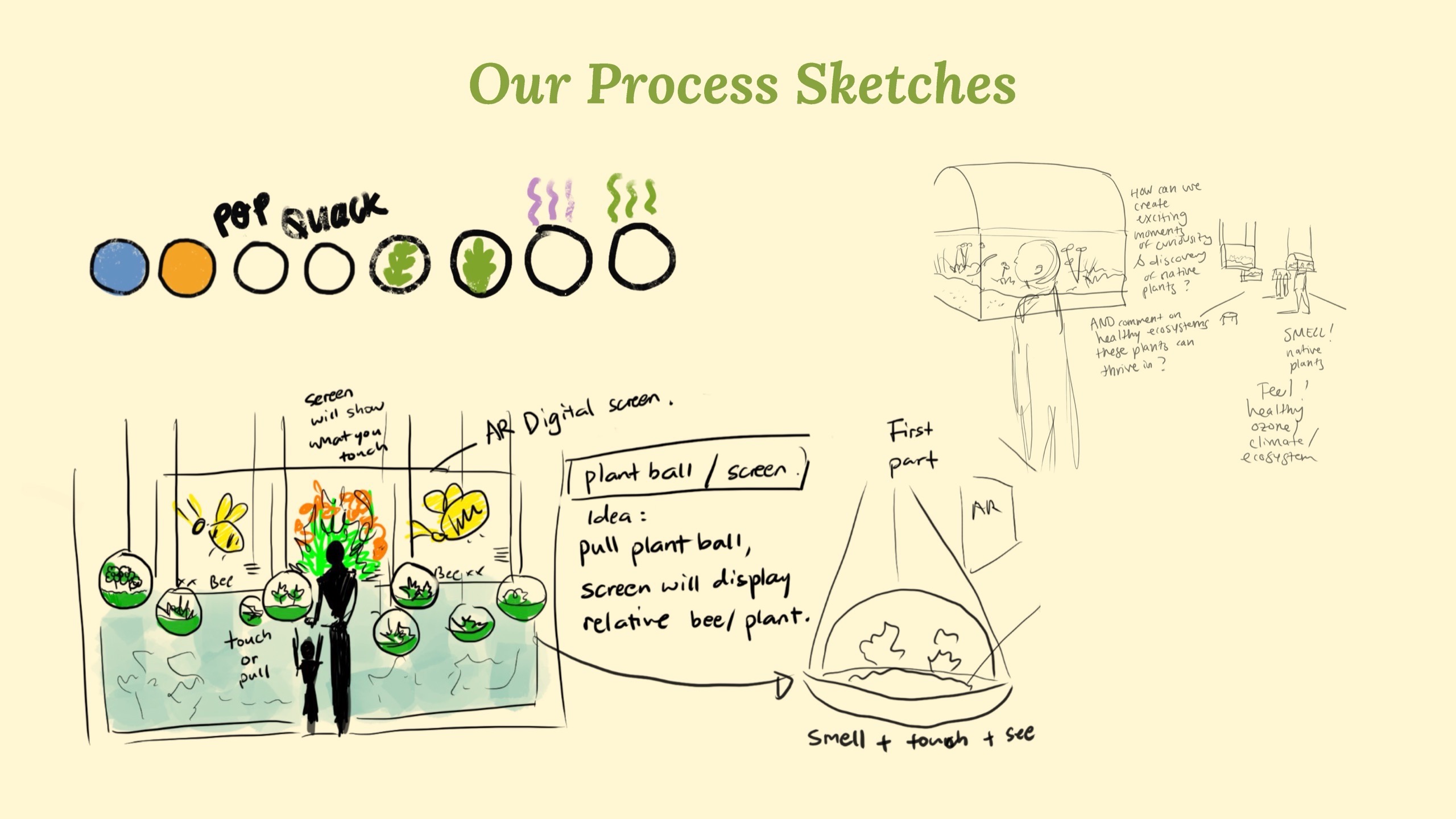
This project was a good example of taking a large abstract problem and putting it into a local experience. We’ve had opportunities for students in the area to research in places like the L.A. Arboretum and in their own backyard. Looking at where native bee populations are represented – or not represented – really pushed our students to grapple with how the local is connected to the global. This class didn’t allow students to get lost in an abstract but to see how they can influence where they are.
Josh Halstead, instructor
Midterm Presentation
In just a few weeks from their development presentations, student teams built out their concepts which they shared to virtual audiences; and described the reasoning behind the directions they were considering along with initial sketches, photo mock-ups, storyboards and scale models.
Experts provided creative feedback and commentary on the progress of the teams’ ideation. Their enthusiastic response and practical advice boosted the students to start a new – and final – phase of their design process.
Teams examined and refined their concepts on a more specific level, adding details, graphics, fonts and colors to their various campaign elements. Many opted to craft and test prototypes, compose technical drawings and create video elements for final presentation.
Additionally, students developed personas and put them inside their projects, following their needs and wants, seeing how they and other diverse audience members would experience, enjoy and learn from their proposals. These persona journeys illuminated how experiences would unfold through design elements, graphics, environmental structures, and more.
As they worked on their projects, students engaged as a class for a field trip (virtual and in-person) to Crescent Farms. The trip presented reminders about the theme and grounded the students back to the original challenge of the studio.
With only a few weeks left before the final, teams created a working schedule with key dates and assigned roles and responsibilities among team members.
Teams made sure their design proposal would be complete with design story, an appealing name and a system diagram that would connect all their elements. Teams practiced their storytelling and how digital elements would support their narration.
Instructors followed the students’ progress, offering critique, helpful suggestions, and cheerleading when necessary.
Project Outcomes
At the studio final, teams presented more than just their final concepts. They explained their learning journeys often relating specific challenges and detours they encountered. Teams shared what they uncovered during their research, facts that motivated them, interviews they conducted and field work they engaged in to collect specific observations and data.
Many teams incorporated videos that either visually explained their challenge, described their concept, or presented an immersive depiction of their proposed environment.
At the end of their presentations, many teams described Next Steps they envision to bring their design closer to actuality. These discussion prompts encouraged specific feedback from experts and other stakeholders.
Project Outcomes
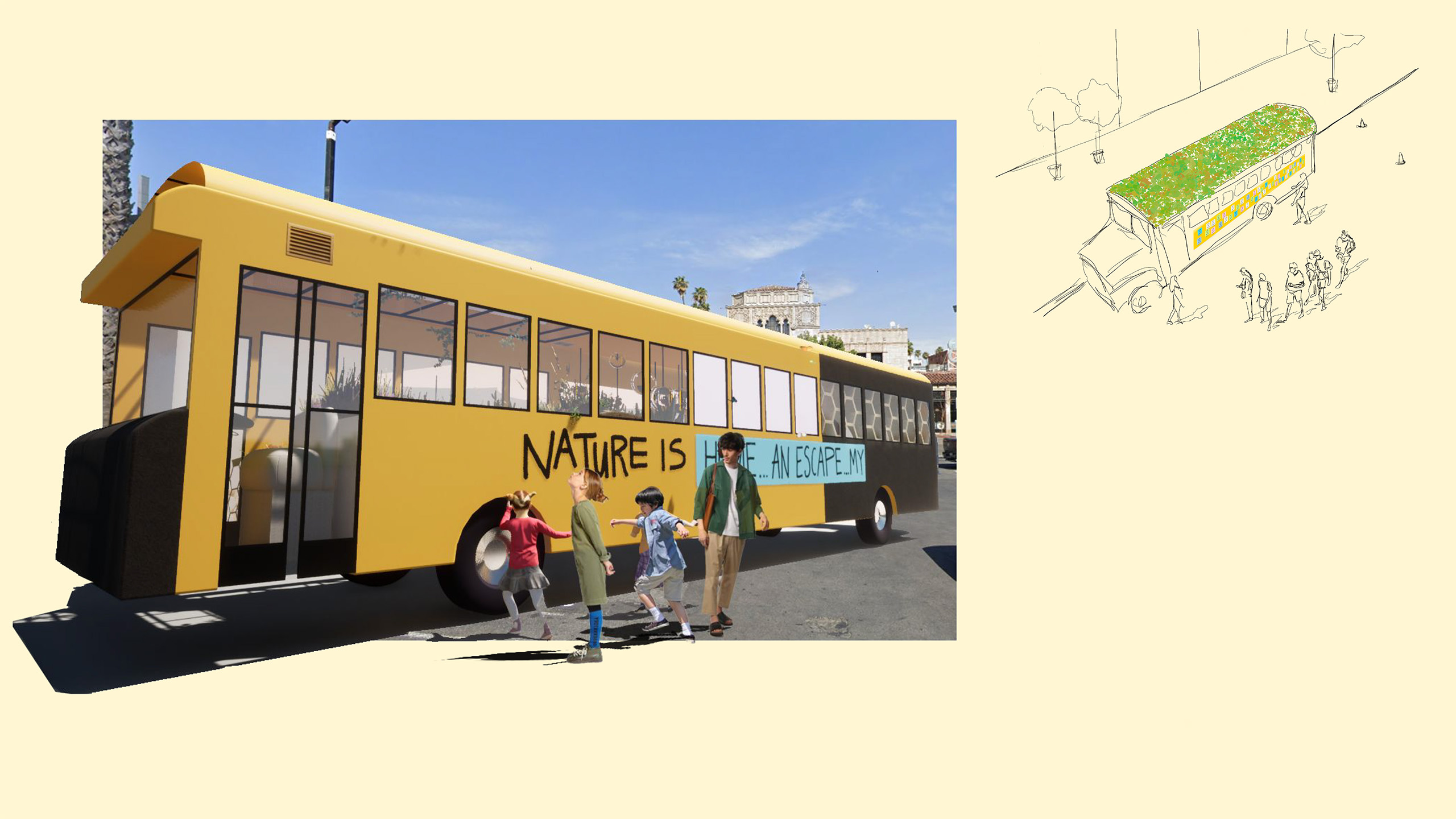 close
close
Bombus
Read moreRachel Chan, Cynthia Lee, Ana-Paola Laveaga
Bombus is a 40 foot-long bus that brings nature experiences to underserved communities though immersive exhibitions about native plants and pollinators while encouraging communities to work together to bring nature into their urban landscapes.
Bombas’ exterior displays colorful fonts and fun designs which attracts attention and establishes the mood for the interior experience. On weekdays, Bombas visits schools; weekends the bus travels to other community locations.
A honeycomb-inspired ramp welcomes guests aboard the bus that is divided into three experiences: observation, curiosity and collective action. Guests encounter live plants which are positioned at different heights for accessibility. Bubble-like pendants are suspended from the ceiling and combine digital information with actual plants. Visitors can color bees and write their nature wishes for the community.
Hexagonal-shaped shelves hold merchandise (seed kits, tote bags, etc.) with engaging graphics. QR codes on items connect buyers to an app that invites them to become a community scientist. The app also lists Bombas’ schedule of upcoming appearances.
Now part of the Bombas community, members can share photos, link to their social media, ask questions and find maps where specific native plants grow along with the diverse pollinators that feed on them.
 close
close
Hollywood Bee Line
Read moreCathy Chen, Nastya Murray, Maya Ruiz
To help alleviate habitat fragmentation in urban areas, this project imagines a bee corridor using bus stops as pathways for bees across neighborhoods often encased in concrete and asphalt. Mobility justice plays a role in this concept since bus riders are often from low income neighborhoods.
The Bee Line will be a series of bus stops from Runyon Canyon along Hollywood and Los Feliz Boulevards up to Griffith Park with hubs at both ends. Bus stops become more welcoming for users with living greenery; empty dirt patches are often found adjacent to the existing bus stops which will be transformed into mini native plant gardens.
Neighbors will help with the creation and caretaking of these bus plots. Sidewalk gardens will feature cheerful pinwheel sculptures that contain information about on-site native plants and the pollinators associated with them.
New benches make bus stops more comfortable. Green open-air canopies will provide better shade protection -- and will also support a rooftop garden and solar lights which will illuminate the area at night. Bus stops will have pots with plants, informational signage/posters and trash/recycling bins nearby.
At both ends of the Bee Line, Bee Hubs serves as educational centers complete with a lending library, bicycle parking, water fountain (designed like a petaled flower) and a gallery wall of nature-inspired artwork co-designed by local children.
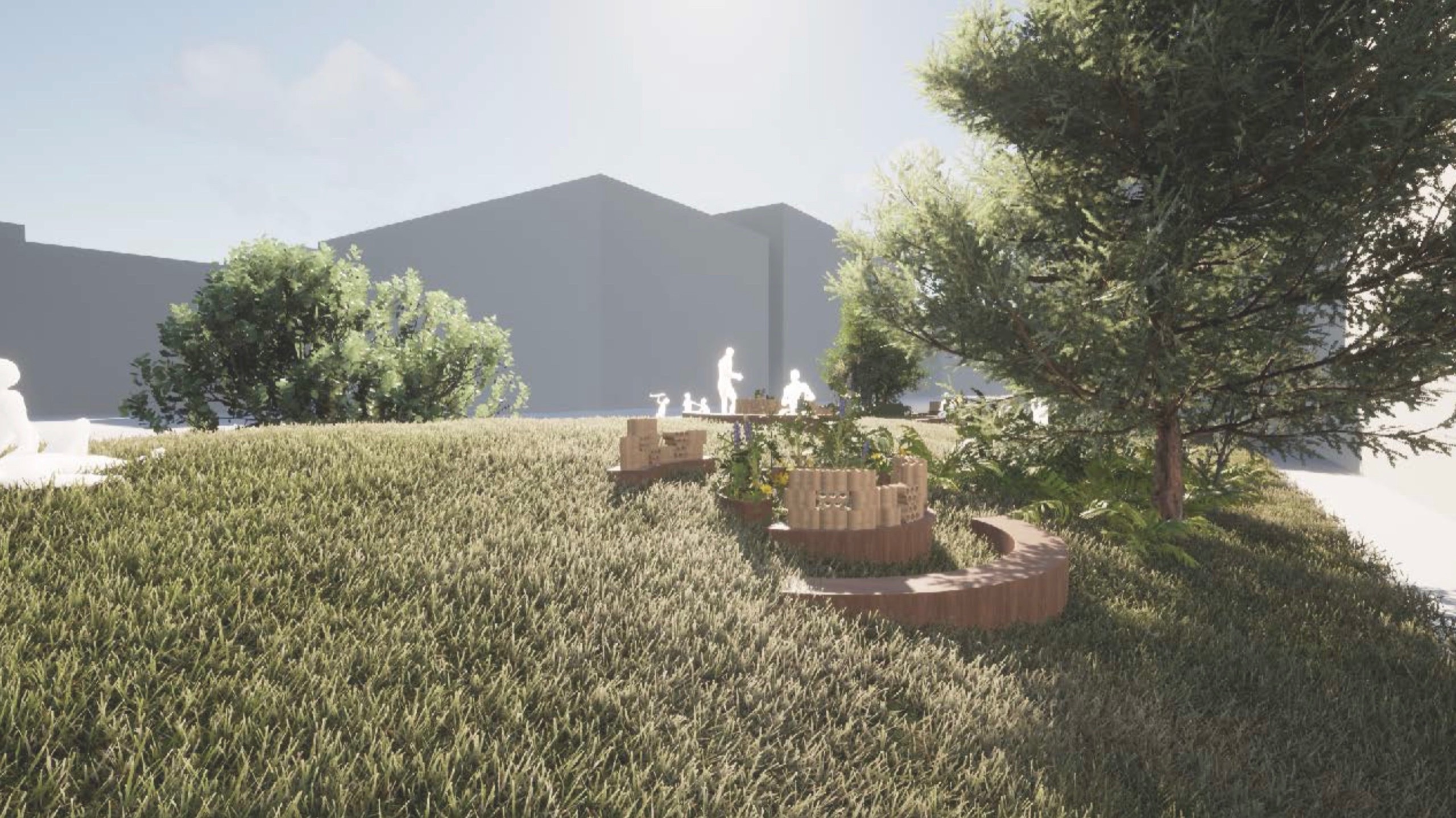 close
close
Refubee Project
Read moreDung Ho, Xinya Gao, Emma Leach, Peggy Luk
To help native bees coexist with humans in an urban built environment, this project repurposes unused city buildings and vacant lots into community bee habitants. Neighbors will enjoy the greenery and through community scientist observations, and help detect pollution levels which can affect both mankind and insect life.
Since many of these locations may have contaminated soil, the key structure in these new green environments are modular compact bee hotels/planters – composed with a hexagonal-shaped reminiscent of a bee hive– which can be easily moved and strategically placed and stacked.
Created with environmentally-friendly rammed earth, these brick-like structures will have a short life span and will easily decompose. Bricks can be fashioned in countless design molds which can be sold to interested gardeners and neighbors.
Community scientists will employ an app to share urban bee observations, photos, resources, plant identification, articles, etc. Professionals will curate and verify content. An easy collection process – swabbing the interior of a recently used bee hotel – will reveal pollution data that can have important scientific ramifications for the insects and nearby communities.
 close
close
BeeFriends
Read moreViola Huang, Wei Heng Hsu, Steven Mao
This project, set on a hiking trail in the Hollywood Hills, near the John Anson Ford Theater, employs sound-driven AR technology to offer hikers opportunities to learn about the small unseen bees they might overlook.
An app guides hikers on a GPS enabled immersive sound experience that is triggered by location and sounds. For example the sound of running water gets louder as hikers reach a desired location. Likewise, the app will vibrant the phone as the hiker approaches the destination which contains an AR experience – such as seeing on their phone a native been lapping water from a real-live stream. Other “invisible” bees are featured via an AR experience including entering the nest of a ground bee or watching a leaf cutting bee chewing.
A native plant garden is located along the hiking trail; the app here also features AR experiences with virtual bees in the physical landscape. Hikers can post their images on social media and will be encouraged to become community scientists to record observations.
The design of the plant garden uses repeated forms of leaves with circular “bites” a tell-tale sign of leaf-cutting bees. An open pavilion features these spatial forms and act as “table tops” of varying heights for guests to view plants, etc. Larger leaf forms are shade structures that also collect rain water and hold solar panels.
Pop-up events can take place at the native bee garden with local businesses selling food, seasonal products and native plants.
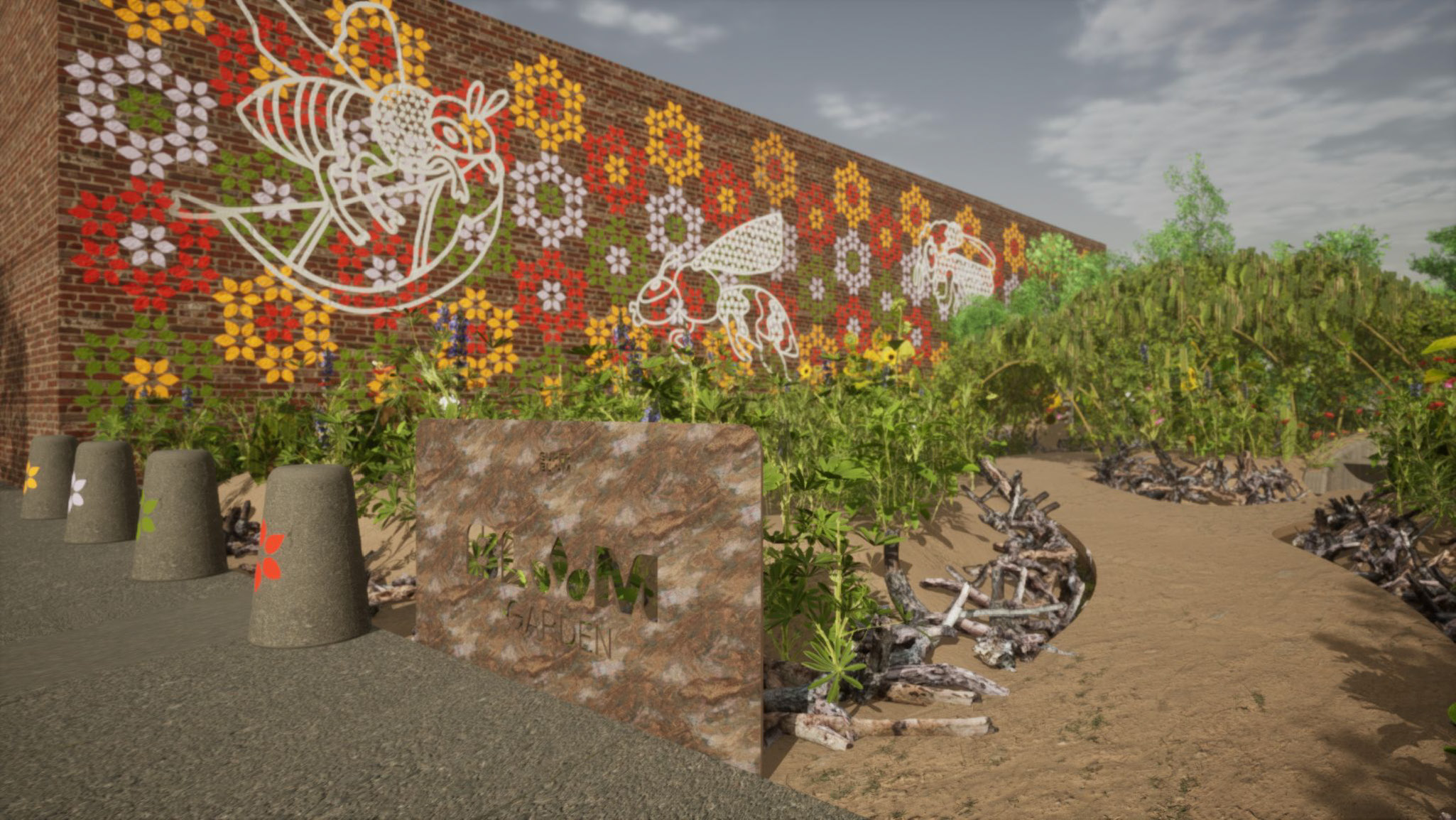 close
close
Super Bloom Initiative
Read moreJanet Kahng, Emma Leach, Peggy Luk
This concept features a circular set of projects that can be experienced separately but can also be taken connectively: community seed libraries, a native plant garden and pop-up event/festival. The concept also deeply involves the traditions and history of the local indigenous peoples.
The proposed project is set in the City of El Monte with various partners: Hahamonga Native Plant Nursery, Calscape and the Chia Café Collective.
Scattered around El Monte will be a network of seed libraries; visitors will approach these appealing candy vending-type machines, turn a knob and receive a handful of native seeds. They can pour their seeds into nearby empty seed packages which are designed with artwork involving the indigenous name/history of that flower/plant along with instruction on how to grow, benefits to native bees, etc. Each library location dispenses different seeds which will encourage multiple visits. Additionally, visitors can leave their own seeds for others as a community seed exchange location.
An ethnobotanical community garden will be created at the pocket park adjacent to the El Monte Valley Mall where a colorful mural on one wall will depict flowers and nature. Food items are grown along with flowers and native trees, bushes, grasses and more. Community members are enlisted to care for the garden. A bent willow structure provides shade over a garden seating area.
The garden will be the location for a cultural event that celebrates local indigenous resources and natural history, a festival pop-up will feature booths including indigenous dishes from the Chia Café Collective. Visitors will learn how they can incorporate these native plants/foods into their daily lives.